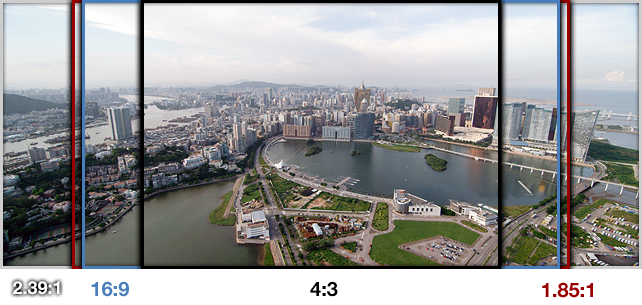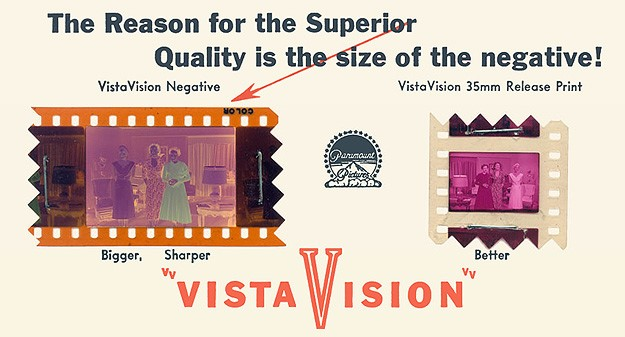Why do some movies have black bars? Aspect ratios, explained

Written by Nicolas Blanchard
9/15/2021
Picture this - you're at Best Buy, looking for a massive TV worthy of gracing your home theater. You pick out a 75" behemoth that will surely be large enough for watching movies in style. You buy it, set it up, and start playing your favorite film (Casino Royale, perhaps). Then, all of the sudden, you notice the obnoxious black bars at the top and bottom of the screen! Congratulations, you just got suckered into buying a TV with 1.553m^3 of real estate, and you're only using 1.155m^3 (74%) of it!*
*Calculations based on the assumption of a scope 2.39:1 aspect ratio
However troubling this may be, you can take comfort in knowing that not all video will have black bars. In fact, most television programs and made-for-TV movies will use the full display, instead of including unsightly black bars. So, the question presents itself - why do some movies have black bars, while others do not? To answer this question, we'll need to consider the evolution of film and the ever changing aspect ratio standards of the 20th century. Our discussion begins nearly a century-and-a-half ago with the first cinema film format: silent film.
Silent Film
Although silent film was first introduced in the 1860s, it was originally difficult to produce and didn't gain traction until the early 1890s. It was this last decade of the 19th century that birthed the first successful motion pictures. The era of silent film lasted nearly 4 decades, during which time 4-perforation 35mm film (yes, the same size commonly used today) dominated the film market (Moss, Wilson). The aspect ratio of these films was the natural aspect ratio of the film frames - 1.33:1 (Pogue). Shown below is a frame taken from The Four Troublesome Heads, an early silent film dating back to 1898. It is displayed on a colored background to illustrate what it would look like on a modern TV.

A frame from The Four Troublesome Heads, with its original 1.33:1 aspect ratio. The red bars represent the unused area on a modern display.
Academy
Watching silent movies is fun, but watching movies with sound is better, right? In the early 1930s, film manufacturers began adding a thin magnetic strip along the side of 35mm film (inside the perforations). This allowed audio to be recorded in conjunction with video, but effectively reduced the usable area for each image frame. The result was a slightly altered, 1.37:1 aspect ratio. Following the introduction of this new format, the Academy of Motion Picture Arts and Sciences (who award Oscars) officially endorsed the 1.37:1 aspect ratio in 1932 (Kirby). This ratio became known as the 'Academy' ratio and became the new standard.

Above is a frame from Citizen Kane, a very famous example of film in the Academy aspect ratio. Although similar to the previous 35mm ratio, it displays a slightly wider image due to a reduced film frame area.
Cinerama
Cinerama holds a special place in film format history because it single-handedly revived the cinema marked in the States. By the early 50s, home televisions were becoming commonplace, and many people lost motivation to visit the theater. In an attempt to incentivize visiting the cinema, some theaters introduced a radical new format called Cinerama. And I'm not exaggerating when I call it radical. Cinerama utilized three separate rolls of 35mm film and three separate 35mm projectors to create a single, ultrawide image on an extended screen. This wider format used a novel 2.59:1 (Pogue).

Shown above is a frame from Windjammer: The Voyage of the Christian Radich, a film from 1958. This exact frame is from a digital restoration that recreates the original look of the Cinerama projection. An authentic Cinerama projection of this picture would display more apparent seams between each of the three separate projectors. Notice that the frame is curved; Cinerama screens were bent toward the audience to prevent scattered light from each individual projector from washing out the colors of the other two projectors.
Cinemascope
Next, barely a year after the introduction of Cinerama, we arrive at another landmark in cinema history: Cinemascope. Cinerama looked incredible in theaters, but the triple projection system made it unnecessarily tedious and complex. To recreate a similar wide aspect ratio on a single reel of film, the industry (led by Twentieth Century Fox) began using anamorphic lenses to horizontally compress images before they hit the exposed film frames. Then, when the film was projected onto a screen, it was horizontally stretched to reverse the anamorphic compression. It's also worth noting here that the anamorphic process was conceived of decades prior to the introduction of Cinemascope, but it was rarely utilized until after Cinerama boldly blazed the trail into widescreen filmmaking (Pogue). Cinemascope became dominant and the resulting 2.35:1 aspect ratio was quickly accepted as the new standard. To this day, Cinemascope remains the standard cinematic aspect ratio. In modern times, it is abbreviated to 'scope' and refers to a 2.3x:1 aspect ratio.

Shown above is a frame from Casino Royale, a film from 2006. Unlike earlier aspect ratios, the scope ratio displays letterbox black bars (horizontal) rather than pillarbox black bars (vertical).
VistaVision and IMAX
Now, we arrive at what I consider to be the two most interesting film formats. VisitVision (mid-1950s) utilized standard 35mm film, but specialty cameras ran the film horizontally rather than vertically. This meant that film frames were bounded by perforations on the top and bottom instead of the sides. The reason this is so monumental is that it allowed up to 2 times the film area to be used for each frame. The image below shows how a standard 4-perf frame of 35mm is dwarfed by a frame of 8-perf VistaVision. The native aspect ratio of VistaVision is around 1.5:1, but it was often cropped to be wider (up to 2:1) (Abreu).

IMAX film is the modern counterpart to VistaVision. Whereas VistaVision ran 35mm film horizontally, IMAX runs 70mm film horizontally. Each frame occupies a staggering 15 perforations on the strip. A 1.43:1 aspect ratio is achieved with this method. If you would like to learn more about IMAX, then you can read my previous article titled 'Film vs Digital (and why IMAX is great!)'.

Shown above is a frame from Avengers - Endgame, a movie from 2019. Although IMAX has a native ratio of 1.43:1, it is cropped close to a fullscreen 1.778:1 for virtually every application. The result is an image with slight to NO black bars!
Modern TVs
Modern HDTVs have an aspect ratio of 16:9, or ~1.778:1. This standard has existed since the mid 1990s and is virtually the only aspect ratio you can find on modern televisions. What is curious about 16:9 is that it does not exactly match any of the film formats we just discussed. So, how did we arrive at this ratio?
The answer has to do with both film and television. Prior to the 1990s, the standard aspect ratio for television was 4:3. In addition, the standard aspect ratio for films was (and remains to be) approximately 2.35:1. So, in order to best accommodate both television and film, the industry settled on an aspect ratio directly between 4:3 and 2.35:1. Thus, 16:9 displays were born (Pogue).
So, why the black bars?
Now, we return to our original question about why TVs often display black bars when playing movies. The simple answer is that movies aren't filmed for TV; they're filmed for the theater. For a multitude of reasons (the naturally wide scope of human eyesight and the horizontal nature of scene framing being principal), the cinema industry has mostly settled on the scope (2.3x:1) aspect ratio. Unfortunately, this conflicts with the 16:9 (1.78:1) aspect ratio of home televisions. When there are black bars on the display, you're not missing out on any image; you are seeing the image exactly as the director intended and your screen is just taller than necessary.
The good news is that the IMAX format is very much still alive, so there is plenty of fullscreen cinematic goodness available to watch on your TV. Christopher Nolan is especially partial to filming on 70mm IMAX and then cropping the result to fit snugly on a 16:9 screen without accompanying black bars. Dunkirk and Tenet, for example, make extensive use of 70mm IMAX.
So, for now, without one concrete aspect ratio to unify TV, cinema, and HD displays, black bars are unavoidable in a home theater.
References
Abreu, Rafael. “What Is VistaVision — A History of Widescreen in Hollywood.” StudioBinder, 22 June 2021, www.studiobinder.com/blog/what-is-vistavision.
Kirby, Ben. “Film Studies 101: A Beginner’s Guide To Aspect Ratios.” Empire, 1 May 2014, www.empireonline.com/movies/features/film-studies-101-aspect-ratios.
Moss, Wilson. Film Appreciation. Affordable Learning Georgia Textbook Transformation Grant, 2020.
Pogue, David. “A Brief History of Aspect Ratios, Aka Screen Proportions.” Scientific American, Scientific American, 20 Feb. 2018, www.scientificamerican.com/article/a-brief-history-of-aspect-ratios-aka-screen-proportions/.

